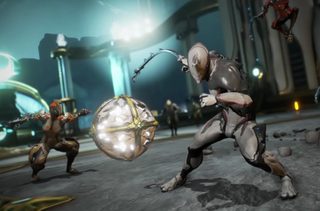
In early 2013, Digital Extremes finally released the free-to-play space-ninja shooter it had wanted to make for over 13 years, but that doesn’t mean it was a happy time for the studio. Every publisher with an opportunity to back Warframe had passed, and most even said outright it would fail. With no investors and a couple of other subpar launches around the same time, employees were laid off and morale was low, but the game was being made.
Almost four years after players first got their hands on it, you won't see a Warframe booth at PAX or E3, or ads on billboards. You won't find reams of op-eds about it on mainstream gaming sites—not like similar games such as Destiny, at least. What you will see is weekly updates and patches, and a regular spot among the top 15 most played games on Steam by concurrent players. With 26 million registered users worldwide, Warframe is one of the most popular free-to-play games available. Digital Extremes did what no one thought it could, and the naysayers are now coming to them for advice.
The idea for Warframe existed as early as 2000, though back then the project was called Dark Sector. According to its first press release in February of 2000, the goal was to merge "the intense action elements of Unreal: Tournament with the scope and character evolution of a persistent online universe." It didn't happen, and the Dark Sector that released in 2008 was something altogether different—and according to an interview with Giant Bomb, the message from publishers was clear: don't do sci-fi. But Digital Extremes never forgot about the original concept.
This concept trailer for Dark Sector from 2004 looks more like Warframe than the actual Dark Sector game released in 2008.
Before Warframe, Digital Extremes was a ‘work for hire’ studio being contracted out by larger developers. It was partnered with Epic Games (then Epic MegaGames) to make the very first Unreal, working on the series through Unreal Tournament 2004. It worked on the first BioShock and developed the multiplayer for BioShock 2. One of the last games Digital Extremes made before starting work on Warframe was The Darkness 2, which creative director Steve Sinclair describes as “a bit of a swan song for us in the old world of ‘You’re a work for hire studio.’”
“You’re not an employee within some publisher beast,” Sinclair continued, “You’re work for hire, and you’re disposable.” Digital Extremes studio GM Sheldon Carter lead the Darkness 2 team and echoed the frustration of not having full control. “I work on Darkness 2 for three years with nothing except for a few publisher people and QA guys looking at it,” he said, “and then it comes out, and it’s polarizing but there’s nothing you can really do about it. You just have to let it sit there and watch it rot.”
You will fail
So when Digital Extremes decided to give the original Dark Sector concept another shot with a new name in early 2012, it was a project filled with passion. “We had one month to make a prototype because James [Schmalz], the owner of the company, was going to GDC to show it [to publishers],” said Sinclair, “Holy shit, were we ever proud of it.” They went all out on that first prototype, even getting the netcode and infrastructure working just to show they could pull it off. They set up meetings with companies he describes as “the most powerful in the free-to-play world” in 2012 and began to shop Warframe around.
PC Gamer Newsletter
Sign up to get the best content of the week, and great gaming deals, as picked by the editors.
“We were just kicked in the ass repeatedly. ‘This is gonna fail, this is gonna fail.’ It was an absolute crisis of faith.”
Steve Sinclair, creative director
Not a single publisher said yes. Most of them said outright that the game was doomed to fail. In many cases, the pitch meetings were over before they could even start. Sinclair told me about a meeting they had set up during GDC, saying it once again all came down to Warframe’s theme. “The executives walk in and say ‘I can’t wait to see what you have today, this is great,’” he recalled, “and they turn, see the screen and see sci-fi, and it’s ‘riiiiiip’ goes the record needle and ‘oh it’s too bad it’s sci-fi,’ and the meeting was over.”
But they kept trying, next going to Korea. Sinclair wouldn’t say exactly who, but he took a meeting with “the creator of the largest free to play game in the world, and I’m not talking about League [of Legends].” He showed a now expanded prototype of Warframe, and despite the publisher being impressed with its graphics, the answer was the same: “You will fail.”
“Western game companies can’t make free-to-play because they don’t update them,” they said, according to Sinclair. “Because they spend way too much time making the graphics good, and they spend way too much time making a type of game that can’t grow and evolve.”

“That was his opinion, that we were absolutely going to fail because we looked too good, and we wouldn’t be able to sustain a game like that. And then he left.” At this point, Warframe was out of suitors. “We were just kicked in the ass repeatedly. ‘This is gonna fail, this is gonna fail.’ It was an absolute crisis of faith.” Sinclair even remembers at one point thinking, “This was a mistake, we’re doomed.” But Digital Extremes didn’t give up, and decided to continue developing Warframe without a publisher—a move Sinclair said “was definitely a Hail Mary.”
“[James] had a lot of faith in the people working on it,” Carter said. “He was willing to risk, and when you have someone who has enough foresight, or trusts the people who are working on it enough to let them spend his money pursuing something that a few people have said is going to fail because he believes in them or he believes in what’s happening ...he believed in it, so he let it keep going.” Without any outside funding, Digital Extremes had to lay off staff to make the game. “It was all-in on Warframe,” Sinclair said, “and it was dark days.”
“It was a fight for survival."
Steve Sinclair, creative director
“We were laying people off who had worked here a long time who we loved,” said Carter, describing the time as “the worst days of the company.” Digital Extremes found even more trouble after its Star Trek game released in early 2013 and was critically panned. "Star Trek almost ruined us," said VP of publishing Meridith Braun. Digital Extremes later told me it let 48 of their roughly 180 person staff go around the time Warframe entered open beta in March and Star Trek shipped in April.
“It was a fight for survival, it really was,” said Sinclair. “I remember even dark places where I was, where we needed to buy servers and people wanted to get the better servers because concurrent counts were rising. And I was just screaming at people, ‘Get the cheap shit, because we just laid people off and it’s not like we’re going to spend beyond our means here.’ Well-intentioned people on both sides, but it was very nerve-racking.”
But there was good news: Warframe's Founder’s Packages—early buy-ins for dedicated fans—were selling. A small but passionate community was forming, and once the ball started rolling, it never stopped. Despite being repeatedly told they were going to fail, Sinclair said they never felt like they had made the wrong choice once they committed, partly because of that founder support. “That initial surge gave us the energy to say ‘OK, we’re going to do this,’ and that let us go all-in.” Even with the supposedly doomed sci-fi theme, Warframe was finding its audience.

Learning from rejection
Some of the credit for its success might actually go to the publishers who rejected it. Because they were so blunt with their doomsaying, Warframe was able to avoid its prophetic failure. Digital Extremes had the largest free-to-play developers in the world telling them exactly what they shouldn’t do, and Sinclair said they used that to their advantage. “We broke it down, ‘Why are we going to fail?’” he recalled, “and that became part of the early foundation of the game, which is why you see a game with procedural levels, which is why you see a game with a lot of permutations and a lot systems that work together.”
The original design still had procedural levels, but called for story or quest missions to occasionally have static, hand-crafted maps. That idea was thrown out after being told in Korea that they wouldn’t be able to update their game fast enough. “I’m glad that happened,” Sinclair said, “because otherwise we would have done things differently. We would have moved slower.” And he’s right to be glad, because a massive part of the reason Warframe is still growing almost four years later is how frequently Digital Extremes updates the game.
“The status quo is so seductive. 'Just let it go. Just keep adding guns and don’t change a thing.'”
Steve Sinclair, creative director
Carter explained that the most recent update was actually broken into three pieces to allow players to get some of the new content quicker. “We had this grand ambition for it,” he said, “and we realized that to realize the grand ambition of it was going to take two or three months.” Two or three months for a large update would be blazing fast for some other games out there, but in Warframe’s world of weekly patches and frequent changes, it’s a lifetime. Digital Extremes has an in-house sound studio and its own motion capture room, and many of the voice actors are employees at the company, allowing the team to record VO as late as the day before it’s being put into the game.
And it’s not just about adding more content. “That’s another lesson we learned from those people we talked to that said ‘you’re going to fail’,” said Sinclair, “they were saying ‘you’ll stagnate. You won’t evolve, you won’t innovate.’” Last year Digital Extremes did a complete rework of Warframe’s movement system affectionately known as Parkour 2.0. Just last week it completely redesigned the star chart and mission select screen, giving it a clearer progression path. With even fundamental game mechanics in flux, I asked Sinclair if he was ever worried about alienating current players.
“That is the every day conversation,” Sinclair said. “The status quo is so seductive. 'Just let it go. Just keep adding guns and don’t change a thing.'” But Carter expressed that it’s important not to get too comfortable. “Let’s just redo the whole star chart and change how people flow through the entire game,” he said, “and that’s going to alienate a lot of people, but then they’re going to get mastery over it and they’re going to love it.” Sinclair continued by saying that “deep in the core of Warframe is this idea that change is good, even though it’s painful for some of our players.”

While at TennoCon, Warframe’s first dedicated convention, I spoke to many of the game’s most passionate fans. I asked why they’re still playing after so many years, and ‘frequency of updates’ was one of most consistent answers I got.
Now Digital Extremes has grown back up to a 260-person company, even hiring back some of the people let go in 2013. Despite what the publishers said, Warframe is still on the rise. “We hear from those [publishers] now," Sinclair said, "and they’re saying ‘can you help us figure out Western free-to-play?’ Because for some reason we figured it out on accident, and they want to know how.”
But even while asking for advice, Carter said those same publishers treat Warframe like a bubble just waiting to burst. “It was almost like they thought we were at the top of the graph, and now we’re going to bottom," Carter explained, "and we always just keep going further up.” Digital Extremes indicated that Warframe hits roughly 100,000 peak concurrent players across all platforms each day, and that those numbers aren't dwindling. Sinclair described the game’s growth as sort of a staircase pattern, saying “every major update breaks [a record]” compared to their previous highs.
A rogue success story
Despite its large player base, Warframe's success remains low-key. A lot of people haven’t even heard of the game nearly four years later, and Digital Extremes recognizes that. “I think we are a little bit frustrated by how well known the game is here and there,” Sinclair said, and Carter agreed, adding, “We all think the game can break through and break out bigger, because we have the same feeling. We have this great game and we have tons of people playing it and loving it, yet it doesn’t feel like it’s registered yet to the greater community.”
“Warframe is in a constant state of renovation. There are downsides to that.”
Steve Sinclair, creative director
For one, Digital Extremes doesn’t do much large-scale marketing for the game, possibly a symptom of the frugal origins of Warframe’s development. For example, they held a panel at this year’s PAX East but didn’t actually have a booth on the floor like many of the game’s competitors. “If we had a big booth, would that make it seem like we’re more real?” Carter asked. “But that flies in the face of what Steve was talking about before, which is we’re not going to spend money there, we’re going to put everything we can into the game.” Carter pointed out that “maybe that’s changing,” citing a Warframe cartoon they announced last weekend, but Sinclair says “those trade-offs have been agonizing.”
Another reason for Warframe’s lack of widespread interest could be its high barrier to entry. A lot of criticism has been focused on the new player experience, which Sinclair admits they prioritize less than making content for current players. “It’s kind of why the new user experience of Warframe kinda sucks,” he said, “because every update it’s like well, we have our players—what can we do to engage them now? Do I worry about the marketing that’s going to pull in the new users and that first hour that they have?” Sinclair went on to say that they “just want to make [Warframe] more interesting,” but that the strategy does make the game harder to learn.

As more is added, the complexity of different systems interacting with each other increases. “Warframe is in a constant state of renovation,” Sinclair said. “We always want to make it feel like you can play this game in 2012 or you can play it in 2016. It’s still going to be relevant, it’s still going to feel modern. It’s going to still feel like we care about it every day. It’s not abandoned. That comes with those downsides.” Sinclair also explained that they do retire certain features as they go stale, but both he and Carter admitted even they can’t remember all the stuff they’ve added to Warframe at this point.
Digital Extremes’ focus on the very things people said couldn’t be done is, for the most part, what’s made Warframe so successful. It looks gorgeous, it kept the sci-fi theme—ironically, a setting that's all the rage right now—and when somebody said they would never be able to update it fast enough, they overcompensated by making the entire game about updates. In a way, Warframe has been designed as a frame for whatever new type of weapon or system designers such as Sinclair and Carter can think to throw into it.
I asked if there would ever be a Warframe 2, and they both smiled. “That’s our joke, man,” Sinclair said. “We always joke about that. This is our Warframe 2 and Warframe 3 and Warframe 4 and all those things. There’s probably some marketing angle to be tempted to do what you’re talking about, but I don’t think so.”
Most Popular




